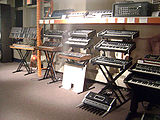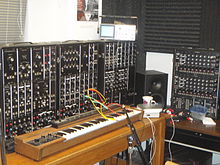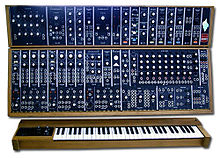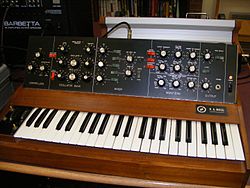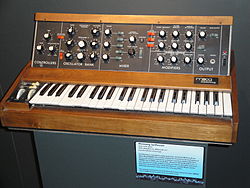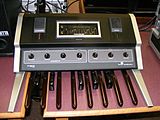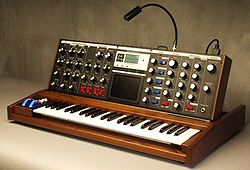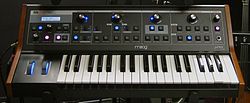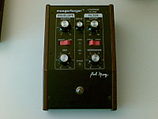- Moog synthesizer
-
Historical Moog synthesizers[1] Moog synthesizers in early 1970s Moog synthesizer (pronounced /ˈmoʊɡ/ mohg; often anglicized to /ˈmuːɡ/ moog, though Robert Moog preferred the former[2]) may refer to any number of analog synthesizers designed by Dr. Robert Moog or manufactured by Moog Music, and is commonly used as a generic term for older-generation analog music synthesizers. The Moog company pioneered the commercial manufacture of modular voltage-controlled analog synthesizer systems in the early 1950s. The technological development that led to the creation of the Moog synthesizer was the invention of the transistor, which enabled researchers like Moog to build electronic music systems that were considerably smaller, cheaper and far more reliable than earlier vacuum tube-based systems.
The Moog synthesizer began to gain wider attention in the music industry after it was demonstrated at the Monterey International Pop Festival in 1967. The commercial breakthrough of a Moog recording was made by Wendy Carlos in the 1968 record Switched-On Bach, which became one of the highest-selling classical music recordings of its era.[3] The success of Switched-On Bach sparked a slew of other synthesizer records in the late 1960s to mid 1970s. In 1974 the German electronic group Kraftwerk further popularized the sound of the synthesizer with their landmark album Autobahn, which used several types of synthesizer including a Minimoog. German-based Italian producer-composer Giorgio Moroder helped to shape the development of disco music.
Later Moog modular systems featured improvements, such as a scaled-down, simplified, self-contained musical instrument designed for use in live performance. The Minimoog became the most popular monophonic synthesizer of the 1970s, and it was quickly taken up by leading rock and electronic music groups such as Yes and Tangerine Dream.
Contents
Early history
The Moog company pioneered the commercial manufacture of modular voltage-controlled analog synthesizer systems. Company founder Dr. Robert Arthur Moog had begun manufacturing and selling vacuum-tube theremins in kit form while he was a student in the early 1950s and marketed his first transistorized theremin kits in 1961.[4] Moog became interested in the design and construction of complex electronic music systems in the mid 1960s and the burgeoning interest in his designs enabled him to establish a small company (R. A. Moog Co., which became Moog Music and later, Moog Electronics) to manufacture and market the new devices.
Pioneering electronic music experimenters like Leon Theremin, Louis and Bebe Barron, Christopher R. Morgan, and Raymond Scott had built sound-generating devices and systems of varying complexity, and several large electronic synthesizers (e.g. the RCA Mark II Sound Synthesizer) had been built prior to the advent of the Moog, but these were essentially unique, custom-built devices or systems. Electronic music studios typically had many different oscillators, filters and other devices to generate and manipulate electronic sound. In the case of the famous electronic score for the 1955 science fiction film Forbidden Planet, for example, the Barrons had to design and build many different circuits to produce particular sounds, and each could only perform a limited range of functions.
Early electronic music performance devices like the Theremin were also relatively limited in function. The classic Theremin, for example, produces only a simple sine wave tone, and the antennae which control the pitch and volume respond to small changes in the proximity of the operator's hands to the device, making it difficult to play accurately.
In the period from 1950 to the mid-1960s, studio musicians and composers were also heavily dependent on magnetic tape to realize their works. The limitations of existing electronic music components meant that in many cases each note or tone had to be recorded separately, with changes in pitch often achieved by speeding up or slowing down the tape, and then splicing or overdubbing the result into the master tape. These tape-recorded electronic works could be extremely laborious and time-consuming to create—according to the 1967 Moog 900 Series demonstration record,[5] such recordings could have as many as eight edits per inch of tape. The key technological development that led to the creation of the Moog synthesizer was the invention of the transistor, which enabled researchers like Moog to build electronic music systems that were considerably smaller, cheaper and far more reliable than earlier systems, which depended on the older vacuum tube technology.
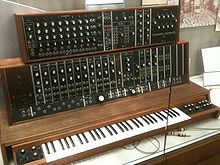 1st commercial Moog synthesizer in 1964, commissioned by the Alwin Nikolais Dance Theater of NY [6]
1st commercial Moog synthesizer in 1964, commissioned by the Alwin Nikolais Dance Theater of NY [6]
Moog began to develop his synthesizer systems after he met educator and composer Herbert Deutsch at a conference in late 1963. Over the next year, with encouragement from Myron Hoffman of the University of Toronto, Moog and Deutsch developed the first modular voltage-controlled subtractive synthesizer. Through Hoffman, Moog was invited to demonstrate these prototype devices at the Audio Engineering Society convention in October 1964,[7] where composer Alwin Nikolais saw them and immediately placed an order.
Moog's innovations were set out in his 1964 paper Voltage-Controlled Electronic Music Modules,[8] presented at the AES conference in October 1964, where he also demonstrated his prototype synthesizer modules. There were two key features in Moog's new system: he analyzed and systematized the production of electronically-generated sounds, breaking down the process into a number of basic functional "blocks", which could be carried out by standardized modules. He proposed the use of a standardized scale of voltages for the electrical signals that controlled the various functions of these modules—the Moog oscillators and keyboard, for example, used a standard progression of 1 volt per octave for pitch control.
At a time when digital circuits were still relatively costly and in an early stage of development, voltage control was a practical design choice. In the Moog topology, each voltage-controllable module has one or more inputs that accept a voltage of typically 10 V or less. The magnitude of this voltage controls one or more key parameters of the module's circuits, such as the frequency of an audio (or sub-audio—"low frequency") oscillator, the attenuation or gain of an amplifier, or the cutoff frequency of a wide-frequency-range filter. Thus, frequency determines pitch, attenuation determines instantaneous loudness (as well as silence between notes), and cutoff frequency determines relative timbre.
Voltage control in analog music synthesizers is similar in principle to how voltage is used in electronic analog computers, in which voltage is a scaled analog of a quantity that is part of the computation. For instance, control voltages can be added or subtracted in a circuit almost identical to an adder in such a computer. Inside a synthesizer VCO, an analog exponential function provides the 1 volt per octave control of an oscillator that basically runs on a volts/kHz basis. Positive voltage polarity raises pitch, and negative lowers it. The result is that, for example, a standard keyboard can have its output scaled to that of a quarter-tone keyboard by changing its output to one-half volt per octave, with no other technical changes.
Using this approach, Moog built a range of signal-generating, signal-modifying and controller modules, each of which could be easily inter-connected to control or modify the functions and outputs of any other. The central component was the Voltage-controlled oscillator (VCO), which generated the primary sound signal, capable of producing a variety of waveforms including sawtooth, square and sine waves. The output from the VCO could then be modified and shaped by feeding the signal into other modules such as Voltage-controlled amplifiers (VCA), voltage-controlled filters (VCF), envelope generators, and ring modulators. Another customization as part of the Moog Modular Synthesizer is the sequencer, which provided a source of timed, step control voltages that were programmed to create repetitive note patterns, without using the keyboard.[9] The inputs and outputs of any module could be cross-linked with patch cords (using tip-sleeve ("mono") ¼-inch plugs) and, together with the module control knobs and switches, could create a nearly infinite variety of sounds and effects.
The final output could be controlled by an organ-style keyboard as the primary user interface, but the notes—individual sounds—could also be triggered and/or modulated by a ribbon controller or by other modules such as white noise generators or low-frequency oscillators. The Moog modular systems were not designed as a performance instrument, but rather a sophisticated, studio-based professional audio system which could be used as a musical instrument for creating and recording electronic music in the studio.[10]
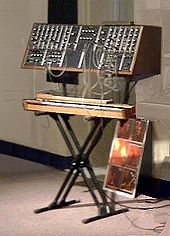 1CA Chris Swanson Modular System in 1965, is an earliest system for demonstration.[1]
1CA Chris Swanson Modular System in 1965, is an earliest system for demonstration.[1]
Moog's first customised modular systems were built during 1965 and demonstrated at a summer workshop at Moog's Trumansburg, New York, factory in August 1965, culminating with an afternoon concert of electronic music and musique concrète on August 28. Although far more compact than previous tube-based systems (e.g. the RCA Mark II) the Moog modular systems were quite large by modern standards, since they predated the introduction of integrated circuit ("microchip") technology; one the biggest of these, the Moog-based "TONTO" system (built by Malcolm Cecil and used by Stevie Wonder in the 1970s) occupies several cubic meters when fully assembled. These early Moogs were also complex to operate—it sometimes took hours to set up the machine for a new sound—and they were prone to pitch instability because the oscillators tended to drift out of tune as the device heated up.[11] As a result, ownership and use was at first mainly limited to clients such as educational institutions and major recording studios and a handful of adventurous audio professionals.
Ca. 1967, through contacts at the Columbia-Princeton Center, Moog met Wendy (then Walter) Carlos, a recording engineer at New York's studio Gotham Recording and a former student of Vladimir Ussachevsky. Carlos was then building an electronic music system and began ordering Moog modules. Moog credits Carlos with making many suggestions and improvements to his systems. During 1967 Moog introduced its first production model, the 900 series, which was promoted with a free demonstration record composed, realised and produced by Carlos.[4] After assembling a Moog system and a custom-built 8-track recorder in early 1968, Carlos and collaborator Rachel Elkind (secretary to CBS Records president Goddard Lieberson) began recording pieces by Bach which were entirely realized on the new Moog. When Moog played one of their pieces at the AES convention in 1968 it received a standing ovation.
- The use of flexible cords with plugs at their ends and sockets (jacks) to make temporary connections dates back to cord-type manually-operated telephone switchboards (if not even earlier, possibly for telegraph circuits). Cords with plugs at both ends had been used for many decades before the advent of Dr. Moog's synthesizers to make temporary connections ("patches") in such places as radio and recording studios. These came to be known as "patch cords", and that term was also used for Moog modular systems. As familiarity developed, a given setup of the synthesizer (both cord connections and knob settings) came to be referred to as a "patch", and the term has persisted, applying to systems that do not use patch cords.
Late 1960s
Max Brand Synthesizer (1968),[12] also known as "Moogtonium",[13] is a custom made Moog modular version of Mixtur-TrautoniumThe Moog synthesizer began to gain wider attention in the music industry after it was demonstrated at the epochal Monterey International Pop Festival in June 1967. Electronic music pioneers Paul Beaver and Bernie Krause had bought one of Moog's first synthesizers in 1966 and had spent a fruitless year trying to interest Hollywood studios in its use for movie soundtracks. In June 1967 they set up a booth at the Monterey festival to demonstrate the Moog, and it attracted the interest of several of the major acts who attended, including The Byrds and Simon & Garfunkel.[14] This quickly built into a steady stream of studio session work in Los Angeles and a recording contract with Warner Brothers.
Some of the first rock recordings to feature the Moog synthesizer included the Diana Ross & the Supremes single, "Reflections" (released July 1967) and prominently throughout albums of the Summer of Love era such as on Strange Days by The Doors (released September 1967)[15] Pisces, Aquarius, Capricorn, & Jones, Ltd. by The Monkees, Cosmic Sounds by The Zodiac,[16] (the latter two both released November 1967), Their Satanic Majesties Request by The Rolling Stones (released December 1967), The Notorious Byrd Brothers by The Byrds (released January 1968), and Simon & Garfunkel's Bookends (released April 1968). Buck Owens made the second purchase of the Moog, his longtime collaborator Jeff Haskell recording Switched On Buck, an album of Owens material recorded entirely on the Moog and released by Capitol Records in 1971. (Carlos purchased the first and Micky Dolenz of the Monkees purchased the third model).
At this early stage the Moog synthesizer was still widely perceived as a novel form of electronic keyboard, not unlike the Mellotron, which had appeared a few years earlier. Most early Moog appearances on popular recordings tended to make limited use of the synthesizer, exploiting the new device for its novel sonic qualities, and it was generally only used to augment or 'color' standard rock arrangements, rather than as an alternative to them—as for example in its use by Simon and Garfunkel on their 1968 LP Bookends and The Beatles' Abbey Road.[17]
According to the American Physical Society, "The first live performance of a music synthesizer was made by pianist Paul Bley at Lincoln Center in New York City on December 26, 1969. Bley developed a proprietary interface that allowed real-time performance on the music synthesizer." However, according to biographical notes on the Hofstra University website, Herbert Deutsch gave a concert at the New York Town Hall on September 25, 1965 with his New York Improvisation Quartet which included the first live performance with a Moog synthesizer.[18][19][20] The Moog was also heard on August 28, 1969 at the Museum of Modern Art in New York in a performance which included Moog and Deutsch.[21][22] Keyboardist/composer Keith Emerson is also pointed as the first musician to play live with a Moog in 1968 with his band The Nice accompanied by orchestra.
Commercial breakthrough
The commercial breakthrough was made by New York-based recording engineer, musician and composer Wendy Carlos who, with producer and collaborator Rachel Elkind, was primarily responsible for introducing the Moog synthesizer to the general public and demonstrating its extraordinary musical possibilities. Carlos worked closely with Moog during 1967-68, suggesting many improvements and refinements to his modules, and during 1967 Carlos composed, realized and produced electronic sounds and music for a demonstration record for the Moog company. Carlos purchased a large Moog modular system in 1968 and then constructed a state-of-the-art eight-track multitrack recorder from superseded studio equipment.[23] Carlos and Elkind then began recording a selection of instrumental compositions by Johann Sebastian Bach, realized entirely on the Moog synthesizer, with each piece painstakingly assembled one part at a time on the multitrack tape.
The resulting album was released by CBS Records in late 1968 under the title Switched-On Bach. It quickly captured the public imagination, becoming one of the highest-selling classical music recordings ever released up to that time and earning Carlos three Grammy awards.[3] The success of Switched-On Bach led to three more successful albums of electronically realized Baroque music by Carlos, as well as the acclaimed electronic soundtrack music for the 1971 Stanley Kubrick film adaptation of A Clockwork Orange, which featured original music by Carlos along with several Moog versions of classical pieces by Beethoven and Rossini. Still in 1968 Keith Emerson purchased the second Moog modular system in the UK after hearing Switched-On Bach. Having problems with its assembly and tuning, he met and collaborated with Dr. Moog so helping to develop even more stable oscillators and many new features for live and studio performance. This led the way to full commercial production of many types of synthesizers on the next decade and brought new rival manufacturers to the market.
In July, 1969 Dick Hyman's recording of his jazz composition "The Minotaur" became the first Moog-based Billboard Top 40 hit single.[24] Other early modular Moog users were Bread on 'London Bridge' released in 1969, Leon Russell on "Stranger In A Strange Land" (programmed by Terry Manning), recorded in 1970, and Terry Manning's Home Sweet Home, (programmed by Dr. Robert Moog himself) recorded in 1968, but released in 1970. The Beatles have also experimented with the use of the Moog synthesizer during the recording of their album, Abbey Road, used prominently in the songs "Maxwell's Silver Hammer", "Because", "Here Comes the Sun", and "I Want You (She's So Heavy)".
The success of Switched-On Bach sparked a slew of other synthesizer records in the late 1960s to mid 1970s. Most of these albums featured covers of songs arranged for Moog synthesizer in the most dramatic and flamboyant way possible, covering rock, country and other genres of music. The albums often had "Moog" in their titles (i.e. Country Moog Classics, Martin Denny's Exotic Moog, Gershon Kingsley's Music To Moog By etc.) although many used a variety of other brands of synthesizers and even organs as well. The kitsch appeal of these albums continue to have a small fanbase and the 1990s band The Moog Cookbook is a tribute to this style of music. Indeed, considering it was the first practical and widely-used analog synthesizer, many people came to use "moog" to refer to music synthesizers.
1970s
One of the most important and successful uses of the Moog in popular music in the early-to-mid 1970s was the extended collaboration between Stevie Wonder and electronic musicians Malcolm Cecil and Robert Margouleff on the series of albums Wonder released during this period. These recordings made extensive use of the duo's large synthesiser system, which they dubbed TONTO (an acronym for "The Original New Timbral Orchestra"), reputedly the world's first and largest multitimbral polyphonic analog synthesizer. Designed and constructed by Cecil, it was based on Moog Series III components, together with additional modules made by other manufacturers including ARP.
The duo's 1971 album Zero Time -- released under the pseudonym "Tonto's Expanding Head Band" -- gained critical acclaim and attracted the attention of many musicians including Wonder. He first worked with Cecil, Margouleff and TONTO on his 1972 album Music of My Mind and the collaboration continued and expanded over his subsequent albums, Talking Book (1972), which won several Grammy awards, Innervisions (1973), which won the 'Album of the Year' Grammy, Fulfillingness' First Finale (1974) and Songs In The Key Of Life (1976).
A more portable version was created and the "Minimoog" was played by a number of musicians, most notably by Jan Hammer in the Mahavishnu Orchestra beginning in 1971. The Mini Moog proved versatile enough to allow Hammer to solo with equal musicality/facility to that of his colleagues John McLaughlin on guitar and Jerry Goodman on violin . Avant garde jazz musician Sun Ra often used the Moog as his instrument of choice to achieve his unique sound. A custom Moog Modular System was also featured prominently on Emerson, Lake & Palmer's song "Lucky Man", Keith Emerson's Moog solo at the end making it arguably the group's most popular piece. Another famous use of the Moog was in Tangerine Dream's electronic landmark album Phaedra in 1974, which was a major hit in the UK—it reached #15 on the British album charts and playing a significant role in establishing the fledgling independent label Virgin Records.
Perhaps the most commercially-successful, pop-industry recording primarily featuring the Moog was of Popcorn (instrumental) performed by Hot Butter and released in 1972, which made #1 in Australia and in a series of European countries, and made the Top 10 in both the UK #5 and in US #9.
In 1974 the German electronic group Kraftwerk further popularized the sound of the synthesizer with their landmark album Autobahn, which used several types of synthesizer including a Minimoog. A single featuring an edited version of the title track became an international hit in early 1975, reaching #25 in the USA and #11 in the UK. Gary Wright was one of the first musicians to perfect the Moog sound on his album The Dream Weaver.
German-based Italian producer-composer Giorgio Moroder helped to shape the development of disco music by incorporating the Moog synthesizer in the 1975 Donna Summer hit "Love to Love You Baby". The use of the synthesizer created the sensual feel that is characteristic of disco and paved the way for Donna Summer's landmark hit "I Feel Love" in 1977. The Moog bassline in this song, combined with the syn-drum created the hi-NRG category of disco music.[25]
In 1976, the Gordon Lightfoot standard The Wreck of the Edmund Fitzgerald would feature a Moog unit that appears on the verse that included the line ... "and later that night when its lights went out of sight, came the wreck of the Edmund Fitzgerald."
In the late 70s and early 80s, Tejano music groups such as Mazz began using Moogs which would later be used as part of what is called modern Tejano.
Bernard Herrmann also used two Moog synthesizers in his chilling score for Brian de Palma's Sisters (1973 film).
Contemporary composer Christopher R. Morgan used nearly two dozen Moog synthesizers for his second album, "The Quad: C."
Product development
Later Moog modular systems featured improvements to the electronics design, and in the early 1970s Moog introduced new models featuring scaled-down, simplified designs that made them much more stable and well suited to real-time musical performance. In 1970 Moog (R. A. Moog Inc. at that time) began production of the Minimoog Model D,[4] a small, monophonic three-oscillator keyboard synthesizer which—alongside the British-made VCS-3 — was one of the first widely available, portable and relatively affordable synthesizers. Unlike the early modular systems, the Minimoog was specifically created as a self-contained musical instrument designed for use in live performance by keyboard players. Although its sonic capabilities were drastically reduced from the large modular systems, the Minimoog combined a user-friendly physical design, pitch stability, portability and the ability to create wide range of sounds and effects.
An extremely important Minimoog innovation was the introduction of its now-famous wheel controllers, with which the musician could easily bend pitch and add modulation effects in real time. The two wheels are mounted to the left of the keyboard, next to the lowest key. The function of the Pitch wheel was assigned solely to control oscillator pitch (either sharp or flat from a default, detented, non spring-loaded center position), whereas its neighboring Mod (Modulation) wheel was assignable to control a mixable amount of oscillator 3 and/or Noise routed to the three oscillators and/or the VCF cutoff frequency. In particular, the intuitive function and feel of the Pitch wheel allowed Minimoog users to create similar expressive pitch-bending effects that musicians such as guitarists achieve by physically 'bending' strings and using "whammy" bars.
Although many other types of left hand controllers have been used by various synthesizer manufacturers over the years - including levers, joysticks, ribbon controllers and buttons - the Pitch and Mod wheels introduced on the Minimoog have become de facto standard 'left-hand controllers' and have since been used by almost every major synthesizer manufacturer, including Korg, Yamaha, Kawai and (the now defunct) Sequential Circuits on their ground-breaking Prophet-5 programmable polyphonic synthesizer (1977). A notable exception is the Japanese manufacturer Roland, who have never included Pitch and Modulation wheels on any synthesizer they have produced, opting instead to include alternative controllers of their own design.
The Minimoog was the first product to really solidify the synthesizer's popular image as a "keyboard" instrument and it became the most popular monophonic synthesizer of the 1970s, selling approximately 13,180 units between 1970 and 1981,[4] and it was quickly taken up by leading rock and electronic music groups such as the Mahavishnu Orchestra, Yes, Emerson, Lake & Palmer, Tangerine Dream and Gary Numan. Although the popularity of analog synthesis faded in the 1980s with the advent of affordable digital synthesizers and sampling keyboards, the Minimoog remained a sought-after instrument for producers and recording artists, and it continued to be used extensively on electronic, techno, dance and disco recordings into the 1980s due to its distinctive tonal qualities, particularly that of its patented Moog "ladder" filter.
The rarest Moog production model was the little Minitmoog (1975–1976), a direct descendant of the rather obscure Moog Satellite preset synthesizer. It is rumored that only a few hundred Minitmoogs were made, although firm numbers are unavailable. While it lacked programmability and memory storage, the Minitmoog did offer some forward features, such as keyboard aftertouch and a sync-sweep feature, thanks to its dual voltage controlled oscillators.
A widely used and extremely popular Moog synthesizer was the Taurus bass pedal synthesizer. Released in 1975, its 13-note pedalboard was similar in design to small spinet organ pedals and triggered bold, penetrating synthesized bass sounds. The Taurus was known for an especially "fat" bass timbre and was used by the bands Genesis, Rush, Electric Light Orchestra, Yes, Pink Floyd, Parliament-Funkadelic, Paul Davis, and many others. Production of the original was discontinued in 1981, when it was replaced by the Taurus II, which never achieved the popularity of its predecessor. In November 2009, Moog Music introduced the limited production Moog Taurus 3 pedal synthesizer, which, the company reports, exactly duplicates the original Taurus I timbre and presets, while adding modern features such as velocity sensitivity, greatly expanded memory for user presets, a backlit LC display, and MIDI and USB interfacing. Still, the original Taurus I units are highly sought after and typically command a high resale value on the used market.
Moog Music was the first company to commercially release a keytar, the Moog Liberation. The last Moog synthesizer released by the original Moog Music, the programmable polyphonic Memorymoog (and subsequent Memorymoog Plus), was manufactured from 1983 to 1985, just before the company declared bankruptcy in 1986. By the mid-1990s, analog synthesizers were again highly sought after and prized for their classic sound. In 2001, Robert Moog's company Big Briar was able to acquire the rights to the Moog name and officially became Moog Music. Moog Music has been producing the Minimoog Voyager modeled after the original Minimoog since 2002. As of 2006, more than 15 companies are making Moog-style synthesizer modules.
In March 2006, Moog Music unveiled the Little Phatty Analog Synthesizer, boasting "hand-built quality and that unmatched Moog sound, at a price every musician can afford". The first limited edition run of 1200 were a Bob Moog Tribute Edition with a Performer edition announced subsequently. In 2011, a number of Moog products can still be purchased, such as Moogerfoogers, Taurus 3 bass pedals and Minimoog Voyagers. The original Minimoog however remains so popular that they regularly sell for over US$3000 on online auction sites.
List of models
- Moog modular synthesizer (1963–1980)
- Minimoog (1970–1981) [4]
- Moog Satellite (1974–1979)
- Moog Sonic 6 (1974–1979)
- Minitmoog (1975–1976)
- Micromoog (1975–1979)
- Polymoog (1975–1980)
- Moog Taurus (bass pedals) (1976–1983)
- Multimoog (1978–1981)
- Moog Prodigy (1979–1984)
- Moog Liberation (1980)
- Moog Opus-3 (1980)
- Moog Concertmate MG-1 (1981)
- Moog Rogue (1981)
- Moog Source (1981)
- Memorymoog (1982–1985)
- Moogerfooger (1998–present)
- Minimoog Voyager (2002–present)
- Little Phatty (2006–present)
- Old School (2008–2009)
- Slim Phatty (2010)
- Taurus 3 bass pedal (2011)
See also
Notes
- ^ a b "Collection checklist". Cantos Music Foundation, Canada. http://www.cantos.ca/explore/collection-checklist.
Several prototypes and early custom build systems of Moog synthesizer are stocked and displayed at Cantos Music Foundation, Canada. For example:
- 1CA Chris Swanson Modular System (1965, custom build) — most left on photograph
Chris Swanson, a composer, was an early demonstrator of R. A. Moog, Inc. - Lyra (1973, prototype) — 2nd row from the left on photograph
- Apollo (1974, prototype, home unit) — stocked
- Patrick Moraz Double Minimoog (1973) — 3rd row from the left
- Micromoog II, Micromoog XL, and Multimoog (1977) — 4th row from the left
- 1CA Chris Swanson Modular System (1965, custom build) — most left on photograph
- ^ Wells, John C. (2009). "Moog". Longman Pronunciation Dictionary. London: Pearson Longman.
- ^ a b Holmes (2002), p. 178.
- ^ a b c d e f Moog Archives - Chronology, 1953-1993
- ^ Moog 900 Series Electronic Music Systems demonstration record
- ^ "This Week in Synths: The Stearns Collection Moog, Mike Oldfield's OB-Xa, MOOG IIIp". Create Digital Music. 2007-03-23. http://createdigitalmusic.com/2007/03/23/this-week-in-synths-the-stearns-collection-moog-modular-mike-oldfields-ob-xa-and-the-moog-iiip/.
"Stearns Collection". School of Music, Theatre & Dance, University of Michigan. http://www.music.umich.edu/research/stearns_collection/index.htm.
Moog synthesizer, Stearns 2035 is known as 1st commercial Moog synthesizer commissioned by the Alwin Nikolais Dance Theater of New York in October 1964. Now it resides as part of the Stearns Collection at the University of Michigan - ^ Holmes, Thom (2002) (2nd ed.). Electronic and Experimental Music: Pioneers in Technology and Composition, pp. 164–65. New York and London: Routledge. ISBN 0415936438.
- ^ R. A. Moog, Journal of the Audio Engineering Society, Vol. 13, No. 3, pp. 200–206, July 1965.
- ^ Holmes, Thom (2008).Electronic and Experimental Music: Technology, Music, and Culture, pp 214. New York: Routledge. ISBN 9780415957823.
- ^ Selinger, Evan (ed.) (2006). Postphenomenology: A Critical Companion to Ihde, pp. 58–59. Albany, New York: State University of New York Press. ISBN 0791467872.
- ^ The original modular VCOs were based on a very-simple (and very inexpensive) unijunction transistor sawtooth oscillator. The exponential computing circuit was temperature-compensated, but also of simple, open construction that made it very difficult (author's personal experience) to trim internally. Beginning with oscillators for the ARP modular analog synthesizers, far more attention was paid to oscillator stability (and frequency range; the Moog was rather limited). This is not meant to denigrate Dr. Moog; he did what made sense in the context of the time. Nevertheless, the landmark record "Switched-On Bach" (W. Carlos) solidly established analog synthesizers as keyboard-controlled instruments.
- ^ "Max Brand Synthesizer". Zaubethafte Klangmaschinen. Institut of Media Archaeologie. http://klangmaschinen.ima.or.at/db/db.php?id=22&table=Object&lang=en.
- ^ "From the Archives: Moogtonium Discovered". Bob Moog Foundation. January 2009. http://moogfoundation.org/2010/from-the-archives-moogtonium-discovered/.
- ^ Brend, Mark (2005). Strange Sounds: Offbeat Instruments and Sonic Experiments in Pop, p. 88. Hal Leonard Corporation. ISBN 0879308559.
- ^ http://www.soundonsound.com/sos/dec03/articles/classictracks.htm
- ^ Holmes (2002), p. 167.
- ^ Braun, Hans-Joachim (ed.) (2002). Music and Technology in the Twentieth Century, p. 75–76. The Johns Hopkins University Press. ISBN 0801868858.
- ^ hofstra.edu
- ^ moogarchives.com
"This Moog synthesizer... was kept by the inventor and his colleague, Herbert Deutsch. It was used in live public performance for the first time in a concert at Town Hall in New York City on September 25, 1965."
The instrument was donated to The Henry Ford Museum in Dearborn, Michigan. - ^ Deutsch, Herbert A. (Fall, 1981). "The Moog's First Decade, 1965–1975". NAHO (New York State Museum).
Excerpt online: [1] - ^ moogarchives.com, Interview with Herbert A. Deutsch
- ^ Moog archives, quoting New York Post 29 Aug 1969
- ^ Carlos, Wendy (1999), Switched-On Bach Boxed Set, New Notes
- ^ Joel Whitburn, Billboard Book of Top 40 Hits. ('The Minotaur' climbed to #38)
- ^ Shapiro, Peter (2000). Modulations: A History of Electronic Music, pp. 42–43. New York: Caipirinha Productions, Inc. ISBN 189102406X.
References
- Trevor Pinch, Frank Trocco, Analog Days: The Invention and Impact of the Moog Synthesizer. Harvard University Press, 2004, 368pp. ISBN 0674016173.
External links
- Using the Moog synthesizer
- The Bob Moog Foundation
- Waves of Inspiration: The Legacy of Moog—an exhibit at the Museum of Making Music, National Association of Music Merchants, Carlsbad, California, in collaboration with the Bob Moog Foundation
- Robert Moog discography at Discogs
Categories:- Electronic musical instruments
- Synthesizers
- Moog synthesizers
- Monophonic synthesizers
- Asheville, North Carolina
- North Carolina culture
Wikimedia Foundation. 2010.


